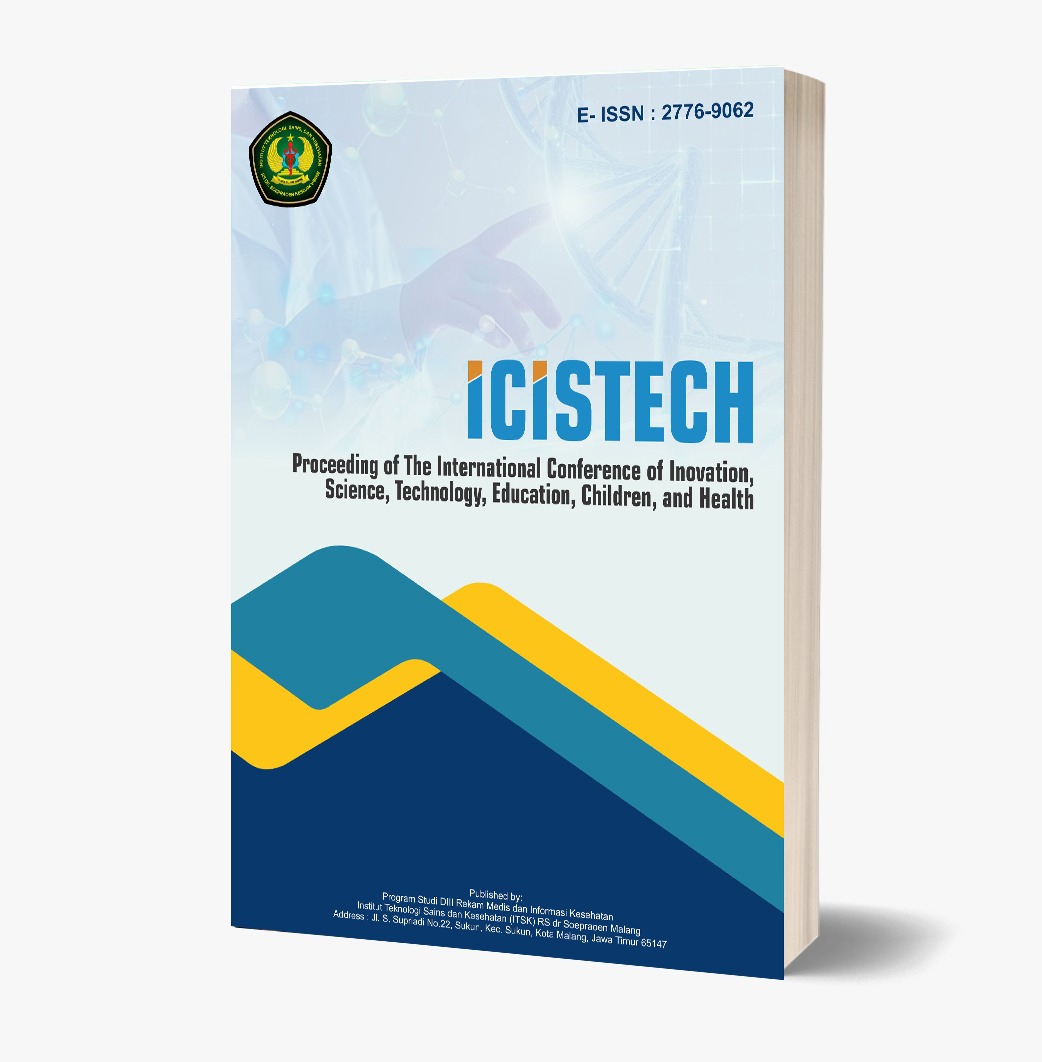Determinants of Health Data Utilization by Posyandu Cadres for Toddlers as a Stunting Prevention Effort in Geneng Subdistrict, Ngawi Regency
DOI:
https://doi.org/10.62951/icistech.v5i1.272Keywords:
Determinants, Cadre, Posyandu, Toddlers, StuntingAbstract
Stunting remains one of the major public health issues at the national level in Indonesia. As an archipelagic country, Indonesia faces unique challenges in tackling stunting, particularly in regions with limited access to healthcare services. Advances in information technology offer new opportunities to support stunting prevention efforts, including through the utilization of health data. Such data can be used to detect stunting risks early and to monitor children's nutritional status more effectively. The use of health data applications or systems by Posyandu cadres is influenced by various factors, including availability of time, cost, level of trust, and perceptions of ease of use and usefulness. This study aims to identify the determinants of health data utilization by Posyandu cadres for toddlers as a stunting prevention effort in Geneng Subdistrict, Ngawi Regency. This research is an analytical quantitative study with a cross-sectional approach. A sample of 80 Posyandu cadres for toddlers in Geneng Subdistrict was selected using purposive sampling. Data were collected through questionnaires and analyzed using univariate, bivariate, and multivariate logistic regression tests to identify the factors influencing the use of health data in stunting prevention. The results show that the significant determinants include the age of the Posyandu cadre, their education level, and the amount of time they dedicate to Posyandu activities. The determinants of age, education level, and time significantly influence the utilization of health data and thereby affect the optimization of stunting prevention. Strengthening cadre capacity in these aspects is necessary to support more effective stunting prevention.
References
[1] E. Agustin, P. Lestari, and P. Kurniasanti, "The relationship between nutrient intake (protein, zinc, iron), parenting, and sanitary hygiene on the incidence of stunting," *Sport Nutr. J.*, vol. 6, no. 1, pp. 37–49, 2024.
[2] E. Nugroho et al., "Social determinants of stunting in Indonesia," *Kemas*, vol. 18, no. 4, pp. 546–555, 2023. doi:10.15294/kemas.v18i4.40875.
[3] Imron et al., "Sinergi lintas sektor dalam percepatan penurunan stunting di Kabupaten Nganjuk, Jawa Timur," *Media Gizi Indones.*, vol. 17, no. 1SP, pp. 239–243, 2022. doi:10.20473/mgi.v17i1sp.239-243.
[4] K. E. Wicaksono and A. G. Alfianto, "Dampak positif pendidikan kesehatan terhadap tingkat pengetahuan keluarga dalam manajemen nutrisi balita stunting," *Conf. Innov. Appl. Sci. Technol.*, no. 3, pp. 981–986, 2020.
[5] K. E. Wicaksono and I. A. D. Satit, "The use of Manajemen Nutrisi," *Indones. Nurs. J. Educ. Clin.*, vol. 6, no. 1, 2021. doi:10.24990/injecv6i1.330.
[6] K. E. Wicaksono, A. G. Alfianto, W. Sriandini, and A. Safitri, "Program laktasi (kelas edukasi orang tua cerdas Indonesia) dalam menurunkan stunting," *Media Husada J. Community Serv.*, vol. 1, no. 1, pp. 34–40, 2021.
[7] Kementerian Kesehatan Republik Indonesia, *Buku saku hasil studi status gizi Indonesia (SSGI) tahun 2021*, vol. 2, no. 1. 2021. doi:10.36805/bi.v2i1.301.
[8] Kementerian Kesehatan Republik Indonesia, *Survei kesehatan Indonesia (SKI)*, Kota Bukittinggi Dalam Angka, vol. 01, pp. 1–68, 2023.
[9] L. Rahayuwati, D. I. Yani, A. S. Setiawan, and M. D. Oruga, "Transdisciplinary approach to prevent stunting in Indonesia," *J. Keperawatan Padjadjaran*, vol. 11, no. 2, pp. 77–81, 2023. doi:10.24198/jkp.v11i2.2295.
[10] M. R. Ginanjar, P. T. Anggraini, and A. Dekawaty, "Effect of health education on knowledge and attitudes of mothers with stunting children," *J. Masker Med.*, vol. 10, no. 2, pp. 701–708, 2022. [Online]. Available: http://jmm.ikestmp.ac.id. doi:10.52523/maskermedika.v10i2.493.
[11] M. R. Nugroho, R. N. Sasongko, and M. Kristiawan, "Faktor-faktor yang mempengaruhi kejadian stunting pada anak usia dini di Indonesia," *J. Obs. J. Pendidik. Anak Usia Dini*, vol. 5, no. 2, pp. 2269–2276, 2021. doi:10.31004/obsesi.v5i2.1169.
[12] Maryati, N. Annisa, and I. Amira, "Faktor dominan terhadap kejadian stunting balita," *J. Obs. J. Pendidik. Anak Usia Dini*, vol. 7, no. 3, pp. 2695–2707, 2023. doi:10.31004/obsesi.v7i3.4419.
[13] N. Ernawati, "Kejadian balita stunting di Posyandu Apel Desa Jambearjo Kecamatan Tajinan Kabupaten Malang," *J. Kesehat. Mesencephalon*, vol. 5, no. 2, 2019. doi:10.36053/mesencephalon.v5i2.108.
[14] P. A. Qolbi, M. Munawaroh, and I. Jayatmi, "Hubungan status gizi pola makan dan peran keluarga terhadap," pp. 167–175, 2020.
[15] P. Sari, Y. Ardillah, and Y. Yuliarti, "Parenting patterns and family characteristics among stunted toddlers in Palembang," *Media Gizi Indones.*, vol. 17, no. 2, pp. 136–143, 2022. doi:10.20473/mgi.v17i2.136-143.
[16] R. M. Septiasari, D. Mayasari, S. W. Purwanza, and C. Nissa, "Pendampingan keluarga untuk pencegahan dan deteksi dini risiko stunting," *GEMAKES J. Pengabdi. Kpd. Masy.*, vol. 3, no. 1, pp. 46–50, 2023. doi:10.36082/gemakes.v3i1.1054.
[17] S. Shorayasari, A. K. Wati, and D. Nurrika, "Faktor yang berhubungan dengan kejadian stunting di Desa Kepyar Kecamatan Purwantoro Kabupaten Wonogiri Tahun 2021," *Amerta Nutr.*, vol. 6, no. 1, pp. 243–252, 2022. doi:10.20473/amnt.v6i2.2022.243.
[18] V. Ismawati, F. D. Kurniati, and E. Oktavianto, "Kejadian stunting pada balita dipengaruhi oleh pada ibu hamil prevalensi stunting di Gunung Kidul menurut data Dinas Kesehatan Gunung," *Syifa’ Med.*, vol. 11, no. 2, pp. 126–138, 2021.
[19] Y. M. G. Gurang, D. Briawan, and Y. Widodo, "Association between maternal feeding patterns and quality of food consumption with stunting among children aged 18-24 months in Bogor City, West Java, Indonesia," *Media Gizi Indones.*, vol. 18, no. 1, pp. 19–27, 2023. doi:10.20473/mgi.v18i1.19-27.
[20] Z. Mutingah and R. Rokhaidah, "Hubungan pengetahuan dan sikap ibu dengan perilaku pencegahan stunting pada balita," *J. Keperawatan Widya Gantari Indones.*, vol. 5, no. 2, p. 49, 2021. doi:10.52020/jkwgi.v5i2.3172.
Downloads
Published
How to Cite
Issue
Section
License
Copyright (c) 2025 Proceeding of The International Conference of Inovation, Science, Technology, Education, Children, and Health

This work is licensed under a Creative Commons Attribution-ShareAlike 4.0 International License.













